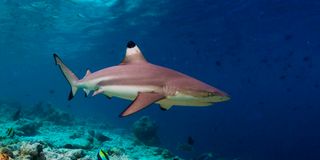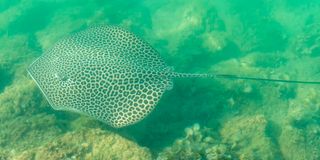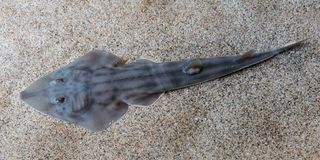Premium
Watamu’s loveable sharks and rays

Blacktip Reef Sharks are listed ‘Near Threatened’, and are common in Watamu Marine National Park.
What you need to know:
- Little is known about the sharks that swim in the Kenyan waters of the Indian Ocean.
- Blacktip Reef Sharks grow to lengths of five feet and are found along the coastlines of Pacific regions.
Sharks have suffered bad press, with the 1975 film titled Jaws sending shivers down everyone’s spine. Yet not all shark species are blood-thirsty human-seeking predators and many are actually harmless.
Little is known about the sharks that swim in the Kenyan waters of the Indian Ocean but here's Peter Musila enlightening us about these ocean creatures.
Peter is a marine researcher at A Rocha (Portuguese word for The Rock), a Christian conservation organisation.
1. Whitetip Reef Sharks
Listed as ‘Critically endangered’, Whitetip sharks are one step away from being extinct in the wild. These nocturnal sharks are rarely seen during the day as they prefer resting under rocks and crevices in coral reefs and shallow water. They come out at night to hunt when their prey is asleep or off guard, which include octopuses, squid, fish, crabs and lobsters.
They are very shy of people and will quickly swim away when they see a diver approaching. They are quite harmless to humans. Whitetips are not large sharks. Most are about five feet long. You can see them along the Western Indian Ocean and the larger Indo-Pacific region.
2. Blacktip Reef Sharks
Blacktips are also not big sharks and grow to lengths of five feet and are found along the coastlines of Pacific regions, such as Thailand, Japan, the Philippines, New Caledonia and northern Australia.
They are also found in the Indian Ocean from South Africa to the Red Sea. Although they are listed ‘Near threatened’, Blacktips are common in Watamu Marine National Park and can be seen swimming in big numbers along the inner reef.
“Blacktips are not a threat to people, considering that Watamu gets thousands of tourists swimming in the beaches. No shark attack has ever been recorded here,” states Musila.
The A Rocha marine team is monitoring this species to study its behaviour, habitat, and threats.
Related to sharks are rays. Look out for these in Watamu:
3. Marbled Electric Rays
These beautifully patterned rays are found in deeper waters along the coral reef, and also sometimes near the shore in rock pools and caves in shallow lagoons. Small compared to other types of rays, they can grow to about 50 cm in length. They are nocturnal and hunt at night. They spend the day buried in the ocean floor, so if you are really lucky, you might see one during the day.
“They have electric organs at the base of their pectoral fins that generate a strong, electric discharge to subdue prey like eels and fish, and to drive off predators,” explains Musila.
“They are one of the most fascinating creatures in the ocean. They move very slowly yet they can produce 10-200 volts of electricity (depending on the species) either to protect themselves from predators or to catch their food. Afterward, it would take them several days to recharge their glands.”
4. Honeycomb Whiprays
Classified as ‘Vulnerable,’, they are seen in the park’s shallow sea grass beds and sand patches. Reaching up to six feet in length, they have beautiful spots that get crowded as they grow which gives them their name – honeycomb.

Honeycomb stingrays are usually seen in the park’s shallow sea grass bed.
“They have a very long whip-like tail and hence the name,” says Musila. “But their sting is not lethal. However, there are other species of rays (stingrays) that have a sharp spine in their tails that can produce a very painful sting if accidentally stepped on.”
Also tells Musila, “Rays are often caught by fishermen in Watamu because they are tasty.”
5. Halavi Guitarfish
A critically endangered species close to becoming extinct in the wild, the Halavi guitarfish is found in the sea grass and sandy beds of the marine park.

Guitarfish have a long, pointed snout and a guitar-shaped body. Compressed from belly to back, guitarfish bodies are attuned to life on the sand.
“These are quite rare to see,” informs Musila. “They are called guiterfish because of their shape which is an elongated body and a wedge-shaped snout that resembles a guitar.”
Best way to see these creatures?
“It’s by snorkelling, scuba diving in the reef or patrolling the sandy beaches,” says Musila.
How you can help conserve these creatures?
“The biggest threat to sharks and rays range from overfishing and habitat destruction to pollution and unsustainable human development,” says Musila.
“You can help conserve them by just being curious to learn, participating in restoration activities like beach clean-ups and tree planting, and being a little less wasteful because so much ends up in the ocean as trash.
“Be respectful to marine life. Do not touch anything, whether live or dead, do not step on corals and do not feed the fish. Learn about marine life and the ecosystems so you can help with their conservation.”
A few metres from the beach and the marine park, are clean and simple accommodation to anyone who loves nature, including longer-term resident researchers. It is a Christian organisation, so do respect etiquette. (Stay at A Rocha’s Mwamba Conservation Centre. https://www.arocha.or.ke/stay-at-mwamba/)




